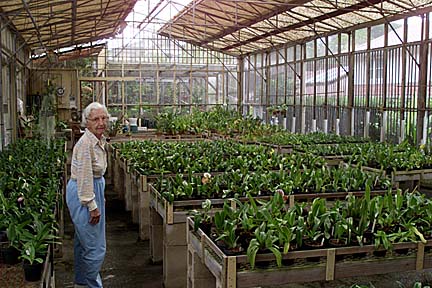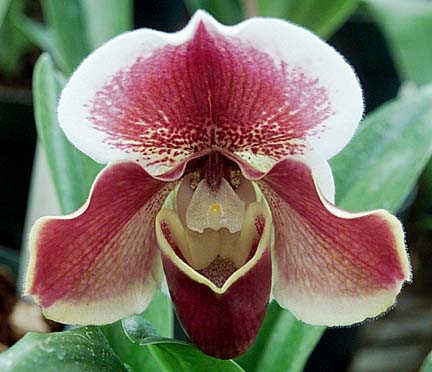


In The Garden![]()
Friday, June 15, 2001

CRAIG T. KOJIMA / STAR-BULLETIN
Slipper orchids thrive in Henrietta Fujiwara's greenhouse.
If Henrietta Fujiwara had to do it all over again, she would make good use of the "garbage can method" of orchid cultivation from day one. Couple’s orchid hobby
got out of hand"That's the one lesson one has to learn: Use the garbage can. When the little ones don't do well, just throw them into the garbage can. Get rid of them," said 89-year-old Fujiwara, who has been cultivating orchids for more than 50 years.
It took her many years before she learned the lesson herself, and by then it was a little too late. Her orchid-growing hobby -- which was a joint hobby with her late husband, Dr. Thomas Fujiwara -- had gotten out of hand.
Orchid cultivation did not take over their lives completely, but the Fujiwaras were more than just backyard hobbyists. They were dedicated (although not commercial) growers who became Hawaii pioneers in hybridizing paphiopedilum orchids, or lady's slipper orchids.
"Hybridizing, that's what did it. That's what made it get out of hand," Fujiwara said. Their pursuit of hybrid orchids meant hundreds and even thousands of seedlings every time they successfully produced a seed pod.

The couple maintained three large greenhouses on their Manoa property, including converting the family tennis court into a greenhouse, to accommodate their hobby."Once I tried counting how many orchids I had. I started but I never finished," Fujiwara said. She counted 2,000 orchid plants in one of the smaller greenhouses and gave up counting.
Fujiwara will be sharing her orchid-growing story, "The Hobby That Got Out of Hand," Monday evening at the Pacific Orchid Society of Hawaii meeting. The public is welcome to attend. The meeting begins at 7:30 p.m. at the Gallery on the Pali, First Unitarian Church of Honolulu, 2500 Pali Hwy. Call 395-0838 for more information.
The first orchids that Fujiwara saw were the three large cattleya blossoms in her wedding bouquet, she said. "A grateful patient" who was a florist provided the white blossoms for the couple's wedding in Ohio, where she was a nurse and he was completing his medical residency.
Another grateful patient gave the Fujiwaras a dozen cattleya plants after the couple moved to Oahu, and that kicked off their hobby. Fujiwara said they did not know much about orchids and had to learn by trial and error, reading and researching.

"Over the years it's been a relaxing thing, something my husband and I worked at together. We thought it would be our investment against boredom in our old age," she said. They used to spend their evenings together in the greenhouses, potting orchids.At first they grew cattelya, then moved onto vanda, then dendrobium and finally paphiopedilum. They both loved the exotic blossoms of the lady's slipper orchids, which were rare plants back in the 1950s when they began their collection.
"People really didn't like them. We were told we could not get them to bloom in Manoa," Fujiwara said. They proved the naysayers wrong and became know for their hybridized plants, particularly for breeding pink blossoms from Paphiopedilum delenatii, a rare native of Vietnam.
Douglas DeMoss, a commercial orchid grower with a fondness for lady's slipper orchids, said the Fujiwaras were the first in the islands to begin growing the exotic terrestrial orchids from Southeast Asia. They also produced beautiful award-winning hybrids, he said.
"Orchid hybridizing was not easy when they were doing it. It was hard to pollinate the flowers and produce seeds. But they were successful at it, and they were serious about what they were doing," DeMoss said.
Fujiwara said they pollinated the orchids the old-fashioned way, with a toothpick, and needed a lot of patience to see the seedlings to flowering maturity. Pathiopedilum takes the longest to mature, usually requiring 10 years before the first blossom appears.
"I still have some plants more than 20 years old that never flowered," Fujiwara said. But she is hanging onto them, hoping that they will flower one day. Mostly, though, she has learned to throw out disappointing plants to keep her collection manageable.
"I still keep at it every day. The orchids keep me young. They keep me interested in something instead of spending my time moaning and groaning," Fujiwara said.
Orchid aficionados know the Aiea Orchid Club's annual show is not a show to be missed. The club is not the biggest, but it has some of the best orchid growers in the state. They will be competing for awards at the show with 10 other Oahu clubs.
Check out their outstanding orchid displays beginning today. The show is at Aiea Elementary School Cafetorium and runs from 9 a.m. to 4 p.m. today and tomorrow, and 9 a.m. to 4 p.m. Sunday. Admission is $2 and includes lectures and demonstrations on orchid growing. Call 488-3705.
A talk by Henrietta Fujiwara of Pacific Orchid Society of Hawaii: The Hobby That
Got Out of HandPlace: Gallery on the Pali, First Unitarian Church of Honolulu, 2500 Pali Hwy.
Time: 7:30 p.m. Monday
Admission: Free
Call: 395-0838
Gardening Calendar
Suzanne Tswei's gardening column runs Saturdays in Today.
You can write her at the Star-Bulletin,
500 Ala Moana, Suite 7-210, Honolulu, HI, 96813
or email stswei@starbulletin.com